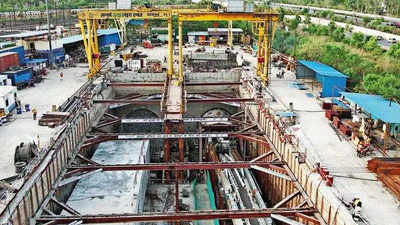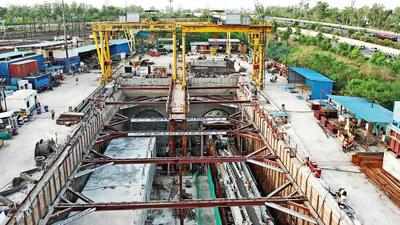- News
- City News
- delhi News
- Work starts on tunnel to link UP-Delhi sections of Regional Rapid Transit System
Trending
This story is from June 28, 2022
Work starts on tunnel to link UP-Delhi sections of Regional Rapid Transit System
The National Capital Region Transport Corporation (NCRTC) has started constructing the tunnel to connect the Uttar Pradesh section of the 82km Delhi-Meerut Regional Rapid Transit System (RRTS) corridor with the 14-km stretch that falls in Delhi.
NEW DELHI: The National Capital Region Transport Corporation (NCRTC) has started constructing the tunnel to connect the Uttar Pradesh section of the 82km Delhi-Meerut Regional Rapid Transit System (RRTS) corridor with the 14-km stretch that falls in Delhi.
NCRTC in a statement said that a tunnel boring machine (TBM) had started work in the direction of Sahibabad from Anand Vihar.Two TBMs are already working on tunnel construction from Anand Vihar RRTS station towards New Ashok Nagar station.
The 14-km stretch in Delhi has four stations — Jangpura, Sarai Kale Khan, New Ashok Nagar and Anand Vihar — of which only Anand Vihar is underground. A 2km tunnel would be built from Anand Vihar towards Sahibabad, which would end in front of Vaishali Metro Station.
The launching shaft for the TBM is at the north of Anand Vihar station, from where the construction of the tunnel has commenced. At the end, a retrieving shaft is being built in front of Vaishali Metro Station. “There will be two parallel tunnels from Anand Vihar towards Sahibabad for arrival and departure of trains,” said NCRTC.
A 17km priority section between Sahibabad and Duhai would be commissioned by March 2023 and the trial run may commence this year. The civil construction work has reached the final stage. The entire corridor would become operational by 2025.
NCRTC in a statement said that a tunnel boring machine (TBM) had started work in the direction of Sahibabad from Anand Vihar.Two TBMs are already working on tunnel construction from Anand Vihar RRTS station towards New Ashok Nagar station.
The 14-km stretch in Delhi has four stations — Jangpura, Sarai Kale Khan, New Ashok Nagar and Anand Vihar — of which only Anand Vihar is underground. A 2km tunnel would be built from Anand Vihar towards Sahibabad, which would end in front of Vaishali Metro Station.
The launching shaft for the TBM is at the north of Anand Vihar station, from where the construction of the tunnel has commenced. At the end, a retrieving shaft is being built in front of Vaishali Metro Station. “There will be two parallel tunnels from Anand Vihar towards Sahibabad for arrival and departure of trains,” said NCRTC.
The TBMs are about 90m long and consist of cutter head, front, middle and tail shields, erector, screw conveyor, and other important parts. Tunnel rings are made underground with the help of segments. Usually, seven tunnel segments are used to form one ring.
A 17km priority section between Sahibabad and Duhai would be commissioned by March 2023 and the trial run may commence this year. The civil construction work has reached the final stage. The entire corridor would become operational by 2025.
End of Article
FOLLOW US ON SOCIAL MEDIA












